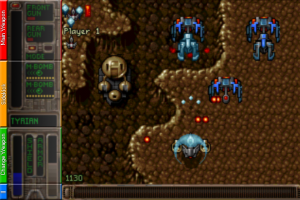iOS Shooter Project: Research
I've had a busy week of research for the iOS Shooter Project and boy, are there ever some interesting shoot 'em ups out there!
After a little bit of Googling and scouring the App Store, I picked 5 shooters to look at in detail. I spent a bit of time playing each one to get an idea of their general feel, common elements, interesting examples of effects or techniques, etc. At this point, I've taken a very general view, and I'm sure I won't have noticed everything useful. But I'm sure I'll be revisiting these games for ideas as I progress with my own design and planning.
ShootEmUp
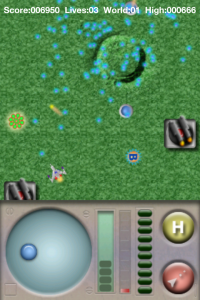 First up is possibly the most easily discovered Shoot 'em up on the App Store: ShootEmUp.
First up is possibly the most easily discovered Shoot 'em up on the App Store: ShootEmUp.
ShootEmUp is unusual among the games I looked at as it uses an on screen joystick as opposed to dragging your ship with a finger. While this prevents you blocking any of the action with your fingers, it does also take up a lot of space on the screen.
This control system does, however, offer a bit more flexibility in play. Your ship's guns only fire when you tap the red fire button, and don't continuously fire if you hold it down. Instead, the guns charge up for a more powerful blast. There is also a "Hyperspace" button that makes your ship disappear and reappear in a random location (as in the classic Asteroids).
Additionally, the joystick method also allows a certain amount of control as to which direction the ship (and thus the gun) is facing. Although this can initially be quite confusing, as it is very different to the straight "upward" shooting of other games. While a neat departure, it doesn't seem to add a lot to gameplay and tactics, so I don't feel that the initial confusion is worth the variation.
In general, the game has something of an "unpolished" feel, with default fonts, aliased sprites and a limited colour palette. Beyond pure aesthetics, some of these qualities made it difficult to tell what was going on at times, and with all particle effects the same colour, it was hard to tell if you'd exploded or picked up a power up. So while graphics aren't everything, they need to be carefully considered so not to detract from gameplay.
ShootEmUp has a fairly shallow learning curve, which helps to ease you into playing before you have any real challenges to overcome. With all the games, I felt this was quite a fine balancing act, as a game becomes boring without challenges, and overcoming them can help get you hooked. However, you need to be invested in a game before your first big challenge, otherwise you can get frustrated and just give up.
Finally on the gameplay front, level progression isn't exactly clear in ShootEmUp, indicated just my a quick flash at the bottom of the screen. This was easily missed, and the additional lack of breathing room meant it was harder to enjoy your success. With the only way to get a break being to turn the game off, I tended not to get too engrossed in play. So another lesson learned, levels need to be self-contained and playtested for length.
Tyrian (Lite)
Second up is Tyrian lite, an open source re-release of a PC shooter from 1995. So the feel here is definitely in the retro gaming genre. With a futuristic style reminiscent of many of the shooters of the time, like the Xenon series or Turrican.
Control is in the finger dragging style, but as with ShootEmUp, a lot of screen real estate is lost to a stats bar on the left hand side, turning the landscape orientation into a near-portrait playing area. I tended to avoid looking at this information for fear of missing a key point in the action (and dying as a result). However, a neat addition was a "red alert" style warning around the screen when your shields are low, a nice indicator for your peripheral vision.
Tyrian has both a Story mode and Arcade mode, with a multitude of purchasable upgrades for your ship. Selecting a particular gun for a particular stage is an interesting tactical element, although does go against the "pick up and play" ethos of many iOS games (which is understandable given Tyrian's origins).
SHMUP
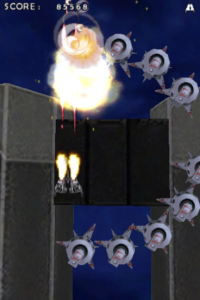 Next is SHMUP, a fast-paced shooter set in a futuristic city scape. With enemies that might very well be robots. Common theme of casual shoot 'em ups: light on the backstory.
Next is SHMUP, a fast-paced shooter set in a futuristic city scape. With enemies that might very well be robots. Common theme of casual shoot 'em ups: light on the backstory.
Unusually for a top down scrolling shooter, SHMUP features 3D graphics. This is evident mainly in the backgrounds and a neat little intro animation for each level. Using 3D graphics is a nice touch to give a clean, polished look, but ultimately doesn't add much to what is very much a 2D genre.
SHMUP has a very fast pace, set by a quickly moving background and enemies that sweep across the screen and swarm around the player. This sense of pace is also enhanced by an excellent choice of music. Hence it will be important to decide on a general pace and feel for my game as early as possible, so supporting resources can be chosen to suit.
Squarely in the finger drag camp of interface design, SHMUP adds a little additional control by turning off the guns (which have more of a continuous laser feel to them) and having a "super weapon" feature activated by a double tap and limited to one use every 5s. While a nice addition, there is no real penalty to just leaving your finger on the screen the whole time so the guns are always firing. The score counter is always incrementing during play, giving you points for surviving, so it might have been a neat addition to only increment it when the guns were off. The super weapon feature is also somewhat hidden unless you take the Tutorial, which is detrimental to the pick up and play nature of iOS games.
Unlike the other games, in SHMUP, there are no shields or armour. One hit kills and you have a set number of extra lives (the exact number dependant on the difficulty level you chose). This is an elegant arrangement, but can be frustrating when you reach odd points where you can't help but die. In general though, when coupled with the fast pace and sheer number of enemies, this does mean that there is a level of tension much higher than in the other games.
Sketch Nation
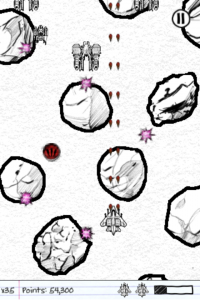 SketchNation Shooter is a slight departure in that it is a Shoot 'Em Up creator. You can build your own shooter by taking pictures of your drawings for the player, enemies and obstacles. Thus it isn't so much one game as a large number of downloadable games, although they all have a number of common elements, which I'll cover here.
SketchNation Shooter is a slight departure in that it is a Shoot 'Em Up creator. You can build your own shooter by taking pictures of your drawings for the player, enemies and obstacles. Thus it isn't so much one game as a large number of downloadable games, although they all have a number of common elements, which I'll cover here.
Another finger dragger, SketchNation has a much slower pace than SHMUP, but this does make for more focused gameplay, with potential for a lot of tense navigation through closely packed obstacles. Much more is made of scenery in SketchNation games, with obstacles being something of a static, yet invincible, enemy type in themselves.
Scoring is fairly simple, awarded for dispatching enemies, with bonus points occasionally being dropped when they are destroyed. Add this to the guns always firing, and you've got a nice, simple gameplay dynamic that leaves room for varied and interesting challenges and tactics.
Sky Force
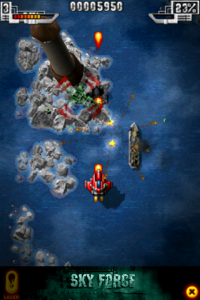 Last up in the research round up is Sky Force, a dogfight themed shooter with an eclectic mix of retro, modern and futuristic aircraft.
Last up in the research round up is Sky Force, a dogfight themed shooter with an eclectic mix of retro, modern and futuristic aircraft.
Sky Force is another finger dragger, with a "lag factor" on the ship, so some varieties catch up to your finger quicker than others. This is combined with varying shield strengths to provide a choice of three ships prior to starting play. Unfortunately, there are also a number of other choices to make before starting a game, and the associated menus are somewhat clunky, nor is there a quick resume feature. So it can take a while to get into play.
There are a vast number of ways to accumulate points in Sky Force. Every enemy drops a bonus star on being destroyed, and some drop a set of "wings" for an additional bonus. Throw in people to rescue, etc and it quickly becomes quite complicated. While this provides some extra challenges, it can be somewhat overwhelming.
Guns are always firing, although at quite a slow rate, which makes timing much more important during play.
Sky Force makes interesting use of parallax and 3D elements to provide a sense of perspective, clearly separating ground and air-based enemies. A nice effect, although primarily aesthetic. But it does go to show how 2D and 3D can be used together without it being jarring.
Finally, Sky Force has smaller sprites than some other games, which means there can be more enemies on screen without the screen being cluttered or busy.
Conclusions
Overall, the finger dragging style of control is far more popular than joystick control, and still offers a little flexibility as SHMUP shows. I think this will be a suitable choice for my own game, although for simplicity's sake, I'm going to stick with the guns always on approach. To make the gameplay more interesting and challenging in a simple way, I'm going to go with Sky Force style slowed rate of fire.
Enemy types could be bundled based on a few qualities:
- Pattern of motion
- Weapons (or none)
- Shots to kill
- Size
More complex enemy types, such as segmented or swarming groups, can be achieved by careful application of these attributes. Terrain can be divided into layers, with the topmost layer (where the player is) being treated as collidable obstacles.
For simplicity's sake, an arcade style can be adopted, with as few clicks as possible to get into the action of a new game. However, later levels should be quickly accessible again once they've been played, to avoid frustration when having to stop a game (as I tend to play games on the tube this is a frequent occurrence for me).
Weapon upgrades would be a nice way to add variation to a game. Again for simplicity, this can be done in game as a power up that can be picked up.
Some example types are:
- Single vertical stream
- Additional horizontal streams
- Multi directional (e.g.: vertical and two diagonals)
- Infrequent homing missiles
Next up: Deciding on concept, theming and play style.

